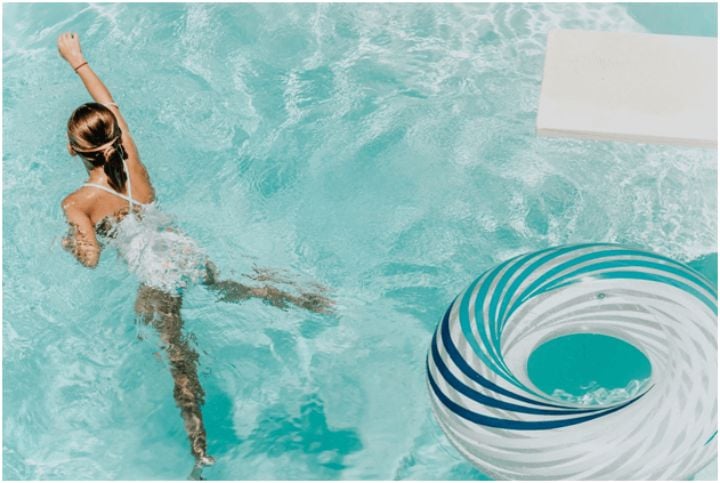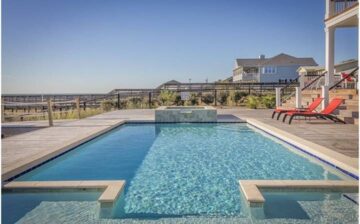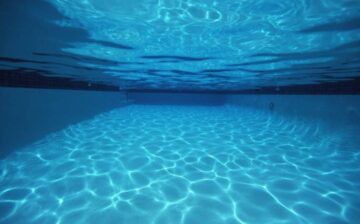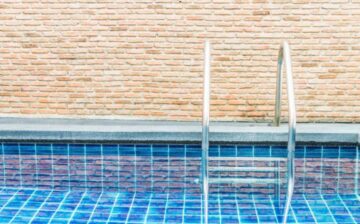
Having your own swimming pool at home is, without a doubt, one of the best assets you can have during the summer months. Not only is it extremely refreshing to take a dip in the cool water when it’s blazing outside, but a home swimming pool can also become the favorite hangout spot of your children and their friends during the summer holidays. That said, a swimming pool is also a huge responsibility, and swimming pool safety is important.
As much as playing in the water is fun, it’s just as dangerous – if not more. If you have young children, you will be horrified to find out that drowning is the number one cause of injury-related death among children from the age of 1 to 4, but it’s also high on the list when talking about older children. Accidents can happen to anyone and at any time, which gives you more than enough reason to take all the safety precautions seriously. Therefore, if you have a home swimming pool, pool safety is of the utmost importance. Here are 12 tips to ensure that everyone can have fun while staying safe.
Know the Regulations
First of all, we already mentioned that owning a swimming pool is a responsibility in itself. You, as the owner, are responsible for your swimming pool being built in accordance with laws, so being familiar with all the local regulations before you start installing this amenity is extremely important. Your safest bet would be consulting with professionals in pool construction to make sure everything is how it should be. Even if your pool was built some time ago and has already been in use, it might be a good idea for contractors to evaluate its safety. Contractors will make sure your pool is up-to-date with new regulations that you might not know of, too – for instance, some parts of Australia introduced new spa and pool safety requirements in 2019 all owners have to comply with.
Mind the Ladders
Your pool is going to need ladders, but not just any ladder will do. Pool ladders’ steps have to be at least three inches wide so that they are comfortable to step on and do not cause slips. Ladders must also have handrails on both of their sides, and the size of these rails should be appropriate for the small hands of children as well. If your pool has built-in steps, the same applies to their handrails as well. In addition, your pool should have ladders on both of its ends. If one end has steps, add a traditional pool ladder to the other. As for above-ground pools, make sure the ladder or steps are sturdy to prevent falls. When the pool is not in use, it would be best to remove the ladders.
Enclose the Swimming Pool
Some places require enclosing swimming pools, others don’t. Still, you should not risk the safety of your children and enclose your pool with a fence on all sides. You should consult your own state’s laws when it comes to the specifics, but usually, the fence must be at least 5 feet tall. You might want to make it even taller to prevent children from attempting to climb over it. The fence should have a gate that can be locked so that no one enters without supervision. Always check the fence to make sure it’s not damaged.
Add a Cover
It might also be a good idea to install a safety cover on your pool for several reasons. A rigid cover that fits over your entire pool will eliminate the dangers of someone accidentally falling into the water when no one’s around. However, for this, it is crucial that there are no gaps by the edge where a child might slip under the cover. In addition, the cover must also be in a good condition – if you notice signs of damage, deal with them as soon as possible.
Make It Non-Slip
A swimming pool has many potential dangers and not all of them are related to drowning. In fact, slips and falls are some of the most common swimming pool-related accidents and they can be extremely dangerous as well. Slip-related injuries often happen due to horseplay, which is why it is extremely important to teach your children how to behave around swimming pools. However, they can happen unexpectedly as well due to all the slippery surfaces that surround swimming pools. So, keep this in mind from the get-go and surround your swimming pool with a non-slip deck material. Poured concrete, cement pavers, or wood treated with anti-slip varnish are solid options. You can also use non-slip pool mats around the edges of the pool for an extra dose of safety.
Mind the Electronics
Besides slips and falls, another common hazard when it comes to pool safety is electricity. This is something that not all people would think of, but an electric device near the pool poses a serious risk of electrocution. You might find it a great idea to set up a radio near the pool when having a party, but it would be wiser to place it, as well as all other electronics, away from the pool area.
Maintain the Pool
Swimming pool safety does not end with setting up everything according to regulations. In fact, that is only the beginning. If you want your pool to remain safe and stay in shape for a long time, you need to do regular maintenance on it. Check regularly for any signs of wear and tear or damage, as such things can easily render a swimming pool dangerous. If there are any non-slip surfaces or grips that are starting to wear out, it is time to replace them. Pay attention to the area surrounding the pool as well. Wash the deck if necessary. It is also a good idea to call a professional once in a while to check whether everything is working well with the pool. It might save you a lot of money if they detect a problem before it gets out of hand.
Check the Drains
When doing your maintenance routine, make sure you pay special attention to drains and drain covers. Pool drains can be a hazard for children (or even for adults) as they can trap hair or swimwear, pulling the child down. All in all, it would be for the best if children were not let near swimming pool drains, if possible. While residential pool drains are not as strong, it is still extremely important to make sure all drains have an appropriate cover that is intact. Checking the drains is also recommended because neglected drains might collect debris. This will clog your filtration system and you will experience problems cleaning your pool.
Keep the Water Clean
Everyone loves a sparkly clean swimming pool, but the aesthetics of it are not the only reason why you should keep the water clean at all times. Firstly, accumulated debris on the surface of the water will eventually sink down, making it much harder to remove. This debris will end up in your filtration system, causing you problems, as we already mentioned. So, skimming the surface to remove leaves, twigs, and any other debris every day is recommended. It will be easier to keep your eye on your children if there are no unnecessary items in the water, too. Besides the debris, it’s also important to keep the water clean of “invisible” threats. If the water is not sanitized properly, bacteria will accumulate in it. Needless to say, this is a potential health risk. Sanitize your water by adding chlorine as needed. You also need to constantly monitor your pool’s chemical balance and adjust the pH level, the total alkalinity, and the calcium hardness. You can easily test all of these with a test kit. Since there are a lot of chemicals involved in pool water maintenance, make sure you store all of these in a safe place, locked away from children’s reach. As you can see, making sure the pool water is clean is going to be an important part of your pool maintenance routine.
Be Prepared
While it is impossible to foresee accidents, it is very much possible to prepare for them in case they do occur. The same is true for swimming pool safety. What you’ll absolutely need to do is prepare a rescue kit, a first aid kit, a phone, and a pair of scissors, and keep them by the pool at all times. Your rescue kit should include a safety ring and a life hook that can be used in case someone is drowning. Besides having a first-aid kit, it is also essential that you are familiar with first aid yourself. Learn all the basics, including CPR, to make sure you are prepared for any kind of scenario.
Educate Your Children
First of all, if you have a pool, consider it an utmost priority to teach your children how to swim as soon as possible. Relying on flotation devices is not safe, not even in shallow water. Swim lessons will teach the child not only how to swim, but they will also learn other important safety rules along the way. That said, you still need to teach your children all the pool rules that will ensure their wellbeing. They should not approach the pool alone, horse around, run on the deck, push others into the water or jump into the shallow part of the pool. So, talk to them and make sure they know how to behave for their own as well as for everyone else’s safety.
Always Be Vigilant
Finally, even if your children are well aware of what (not) to do, it is your duty to always stay vigilant and not let anything distract you when watching your kids play in the pool. It’s enough to leave your post for 15 seconds for tragedy to happen, so put your phone away and keep your eyes on your little ones at all times. When you are holding a pool party, it would be best to hire a professional lifeguard while still staying vigilant. To keep an eye out even when you’re not there, you should consider installing an alarm that will alert you when someone opens the swimming pool gate.
If you have a home swimming pool, it is crucial that you be well prepared and armed with knowledge about swimming pool safety. Make sure your swimming pool is safe, teach your children about the dangers, and always stay vigilant. This way, you will be able to enjoy this fun asset to the fullest.
We hope you found this blog post Home Swimming Pool Safety Tips, useful. Be sure to check out our post Things To Consider When Purchasing A House With A Swimming Pool for more great tips!
Have Experience in the Moving Industry? Want an Additional Income Stream? Work With All Around Moving!
Partner with us and we’ll help you profit. Click here to learn more.





